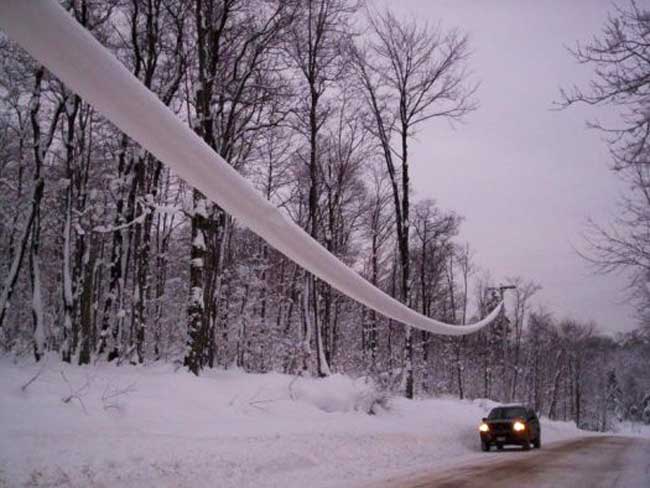FAQ: Global Warming and Snowstorms

Recent blizzards and a cold winter have some people wondering whatever happened to global warming. NOAA, parent organization to the National Weather Service, provided these answers to some common questions:
Q. Do the recent snowstorms suggest that global warming is not really happening?
No. Although record low temperatures were experienced in February 2010 in some regions, these are part of the short-term regional variability that has always been a characteristic of weather and will continue to be even as the Earth’s climate experiences an overall warming trend.
Q. What caused this cold spell, if not global cooling?
The February record snowstorms and the heavy snow from December 2009 were heavily influenced by the current – and predicted – El Niño combined with an unusually strong, long-lasting occurrence of a climate pattern that delivers cold air from the Arctic to the middle latitudes around the globe, called the Arctic Oscillation.
These phenomena are a naturally occurring part of the climate system. We have a good understanding of what causes the El Niño that leads to a wet southeast part of the country for example, but we do not have a good understanding of what leads to the large oscillation in atmospheric circulation we have seen this past year. Understanding of phenomena such as these and their implications for future climate and climate change will be a priority for the newly proposed NOAA Climate Service.
Q. Can you elaborate on the Arctic Oscillation?
Get the world’s most fascinating discoveries delivered straight to your inbox.
An important cause of short-term regional variability in winter weather in the Northern Hemisphere is a cyclic change in the strength and waviness of the jet stream that circles the globe at the southern edge of the Arctic.
When the jet stream is strong it is less wavy and Arctic cold does not penetrate very far southward. When the jet stream is weaker, it zig-zags, with the southward excursions allowing frigid Arctic air to reach ordinarily warmer climes. This cycling between a weak and strong circumpolar jet stream is called the Arctic Oscillation.
This winter we’ve been experiencing a particularly zig-zaggy weak phase of the Arctic Oscillation, with correspondingly large southern excursions of Arctic air. (With the zig-zags go some large northern excursions of warm air, too, with the result that Alaska and Washington, for example, were experiencing record highs during the period when the East Coast was experiencing its cold spell.)
Q. “Global warming” or “global weirding”?
While some locations experienced bitter cold and blizzards, other locations experienced unusually warm and mild conditions. Consider that even as people living in Washington, D.C., experienced “snowmaggeddon,” residents in Vancouver, Canada, experienced their warmest January ever recorded.
Ironically, organizers of the 2010 Winter Olympic Games had to use trucks and helicopters to bring in snow to prepare the slopes in time for skiing and snowboarding competitions. The contrast in weather between these two locations illustrates why we don’t draw long-term, large-scale conclusions about climate from short-lived, local weather patterns.
Q. What is the difference between “climate” and “weather” and why is it important?
Weather and climate are related but they are not the same things. Each describes environmental conditions, but on different scales of time and space. Meteorologists describe the state of the atmosphere at a particular time and place — weather — by measuring its temperature, air pressure, moisture, wind speed and direction, etc. But because the atmosphere behaves like a fluid, these conditions are prone to rapid change. Thus, weather at any one location is inherently difficult to predict more than, say, a week in advance.
Climatologists, on the other hand, don’t try to predict weather at one location on such a short timescale. Rather, they look at the bigger picture. Climatologists consider the much larger context in which weather operates and describe the expected frequency and duration of environmental conditions.
The stock market is a good analogy. Wall Street stock traders deal with the complexities of the stock market’s daily ups and downs. Mutual fund managers, however, don’t worry about the market’s daily volatility. They look at long-term trends and manage investors’ money based upon a long-term perspective and their bigger picture understanding of the underlying market forces that drive the stock market.
Likewise, climatologists aren’t as concerned with what the weather was like last week, as they are in determining the likely range and average of winter weather patterns over the last seasons, decades, centuries, or even longer. More importantly, climatologists want to know why those were the long-term prevailing conditions. Specifically, they want to observe and measure the large-scale, slower-moving environmental forces that drive the state of the atmosphere. So they observe and measure those variables that comprise the climate system in which short-term and smaller-scale weather patterns and climate oscillations operate.
To understand climate and detect climate change we need to collect data for a long time — the longer the data record the better — to determine whether and how global climate is changing. The analogy also shows why predicting any single weather event is inherently difficult and why we don’t base our assessments of climate on any single weather event.
- Photo Album: Antarctica, Iceberg Maker
- 101 Amazing Earth Facts
- More About Global Warming



